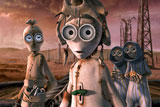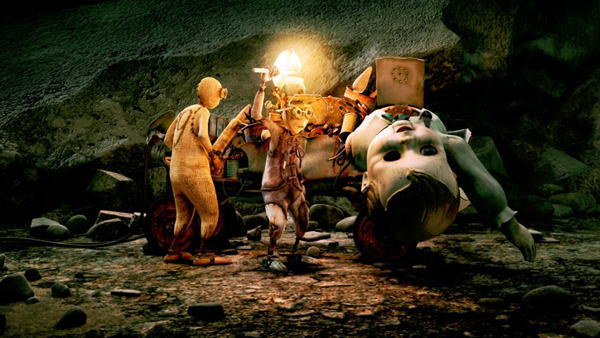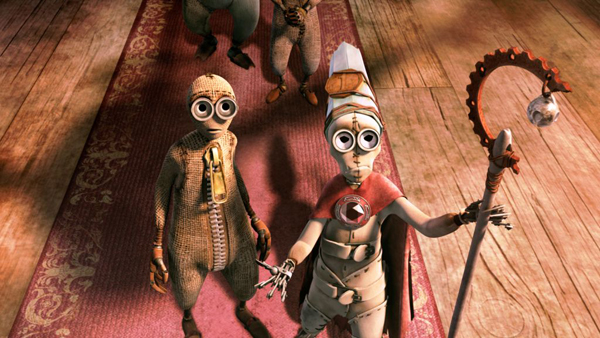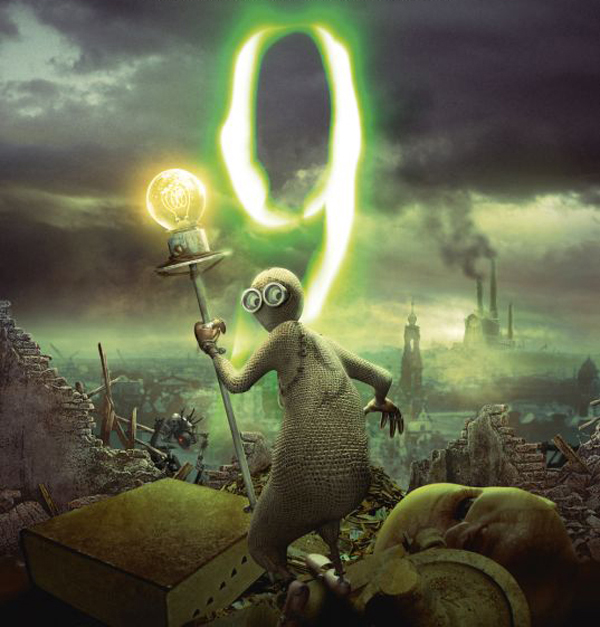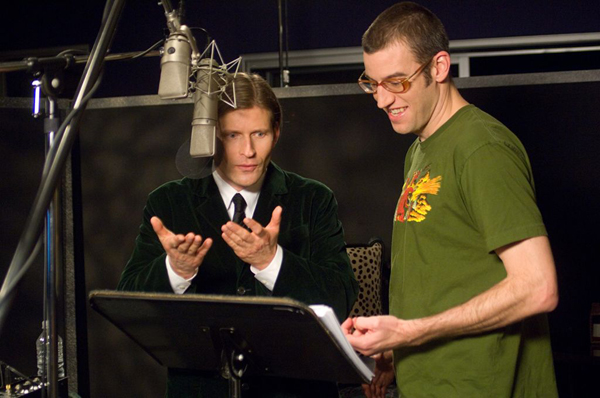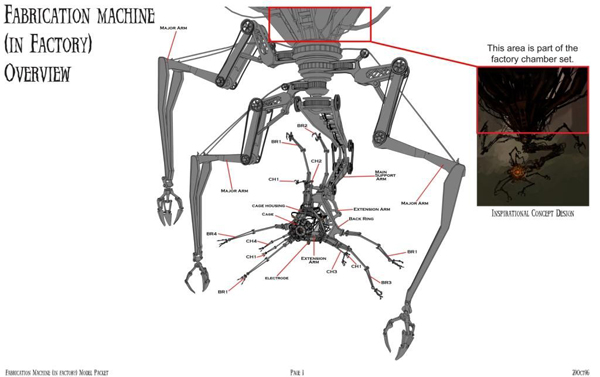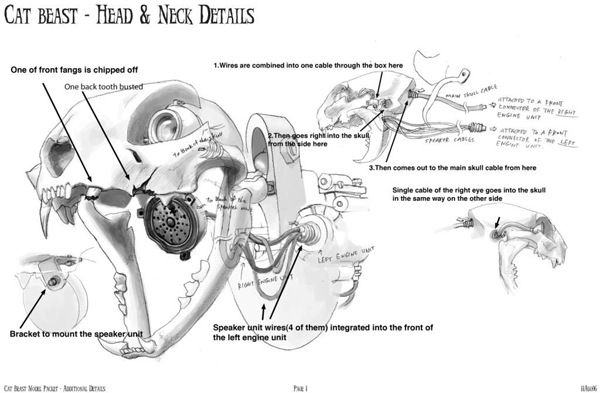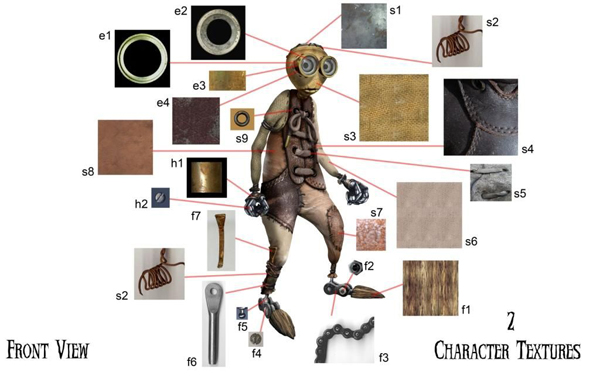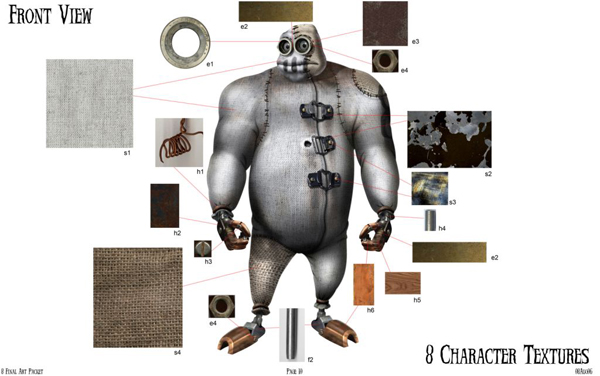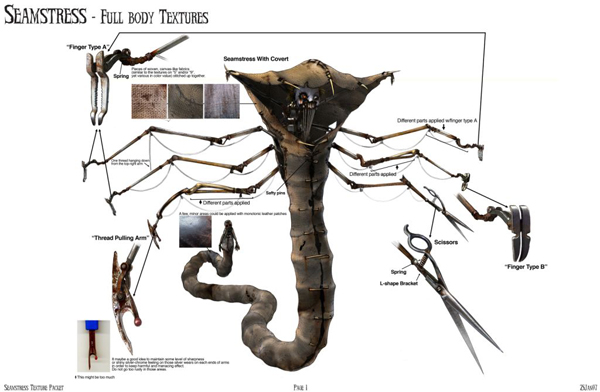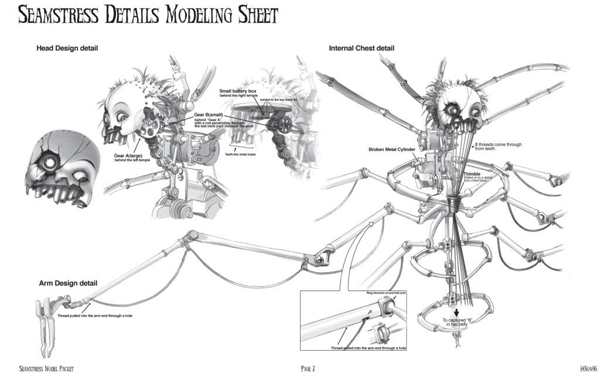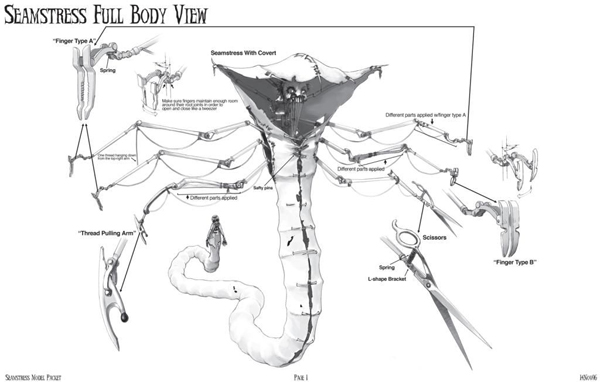|
Character development
Shane has a lot of work to let go of. He calls the heroes of his story ‘shorthand characters’. “Their faces are quite limited. Their eyes are camera lenses like eye cans. Pupils are just apertures that slide around within that space, in a 2D way. They aren’t truly 3D, which makes them a kind of caricature. As an animator, you’re limited with these faces, and can’t get the kind of eye squints or eye-lid shape that you could on a conventional character.” He wanted to portray the materials behaving realistically, metal like real metal, so the animators had to push the fleshy bits of the face against the metal to make eyebrows and other expressive features.
The characters have no tongues or teeth. How to animate speech within such a restrictive design? Speaking was a challenge Shane hadn’t met in his short film. The design forced the animators to emote creatively, and meant the whole body had to express emotion without relying on realistic facial features. “What’s great about that is that the characters really do take on a life of their own and behave in ways that humans don’t. The animators’ challenge was making them uniquely believable. Can the audience begin to see the humanity within these little mechanical creatures? Can we make the audience believe that there are souls inside them? This was the theme of my story.”
Cinematic Animation
The robust sophisticated nature of modern software, in this case Maya 3D, gave Shane Acker a lot of scope to concentrate on the creative side of production on ‘9’. He and his team at Starz Animation Toronto weren’t trying to ‘break technological boundaries’ with this film, but were trying to push outside the traditional box that has contained animation in the past and create something edgier and more dramatic, coming nearer to cinematography with a more live-action sensibility and interesting action sequences.
In the studio, facing a restricted budget and formidable timeframe of 14 months, Shane plotted with the Starz art department and animators how they could best use available, standard technology and push it to its limits. They actually started with almost traditional techniques, such as using matte paintings as 2D pieces of set design with the action confined to a small portion of the frame.
“The 2D art team at Starz includes very experienced, talented matte painters,” said Shane. “As the project progressed, the time and budget constraints forced us to lower our expectations for detail and lean more heavily on the 2D artists, handing them shots straight out of animation and asking them to paint as much as they could – paint in lighting, paint environments – and then pass the scenes to the lighting and compositing departments, thereby saving on rendering.
Matte Painting Maestros
Over time, Starz Animation’s 2D artists have developed tools for dropping matte paintings into shots in preparation for lighting. The painters had to learn how to drop sets into space and turn them towards camera, and developed other tools to project paintings onto surfaces and put transparent paintings on angles to cover edges. The team now have the means to create robust matte paintings.
Shots in ‘9’ often contain several paintings inserted at different distances from the foreground, sitting on cards in space to prepare for the 3D animating camera, each separately affected for compositing. A mist layer could have noise running through it, then real noise could be added in the foreground. Real atmosphere could run through all shots as well. Finally, the artist can move the camera around all these elements.
But it required careful planning. Moving the camera too far off the axis caused the scene to fall apart. The 2D paintings would work in front of the 3D camera only if the operator kept the camera within 25° to 30° of the head-on position. Marrying paintings with atmosphere helped to add volumetric depth also. The film’s expansive skies were inserted as cards in the set, but were usually distorted from the top to make them parallax and all appear to be moving in the correct direction. Effects were added behind and inside them.
Geometry Games
Because they only had time to produce 3D geometry for sets and props that appeared often and in the foreground, matte paintings projected on surfaces or on cards stood in for many buildings, interiors and surfaces. Underpaintings helped give depth. Compromises like building a rough geometry, globally illuminating it and putting in a rough light, might become an underpainting replacing most of a set for a matte painting. A few genuine 3D props could be added with the characters. The fact that the 2D artists creating all these paintings were using Maya, just like the 3D artists, was a help during production.
A fix for some paintings that replaced sets were coverage passes. The artist would plan ahead where the camera will be, perform a pass of it and the go back later to replace what was actually needed with more depth and detail. The technique of building a proxy geometry to put matte paintings over also allowed them to marry effects to their paintings. A building created this way based on a 3D object contained contact points and could therefore be layered into an effects shot.
They used a real, volumetric light tool inside their rendering pipeline. They could paint with some but not all of the light, so they could still layer the lighting over the top, fitting it into the set. Mapping the flat painting onto 3D surfaces remained a persistent problem, of course. Decisions on resolution and 2D vs 3D within the shots depended on viewer time and noticeability.
2.5D Space
They became adapt at using low resolution geometry and projecting high resolution, beautifully, textured and lit matte paintings on top of this. This procedure allowed a certain amount of camera movement with just enough parallax and dimension within a 2.5D space, without having to put a lot of time into modelling, texturing and lighting an entire scene.
“Many of the artists had 3D skills as well and could make a few quick renderings of built assets to use as a base for the matte paintings or as a base for a texture painting, right on top of the surface geometry, said Shane. “Not only did they produce the beautiful, lush textured paintings in 3D, but could pass them to the effects department, where the artists could run particle simulations on top of them, put fire in windows or on buildings, and still achieve wonderful interaction.
“They always put in some kind of atmosphere as well - whether as simulated particles or just more paintings with varying transparency – or turbulence effects, and slide them against each other to create depth and parallax. At the end, adding atmosphere helped integrate 3D characters into the 2 or 2.5D environments and paintings. It was a hybrid approach.”
Starz On Board
As Shane moved into the director’s seat, Starz Animation came on board to take over design and animation. With only 14 months to complete ‘9’, everyone on the team had to be flexible and work fast to make this movie into what it is now. Some started the job as mainly 2D artists, such as Art Director and Director of Photography Kevin Adams, but soon grew into 2D/3D artists, skilled at working within a Maya-based pipeline.
Kevin outlined the challenges the project presented the team. Starz received some original design packs for the characters, which they modified slightly to include more facial detail and more robust rigs, and gain better control of the shapes. The fine mesh covering the characters was a major problem because it immediately revealed areas of stretching. They also wanted to lift the look of the environments. Furthermore, as the camera operator, he found it difficult to shoot with a camera only eight or nine inches off the ground in a world full of rubble.
Ground Up
The art department shifted back a few steps in the development of the existing artwork and organised it into a more robust style guide. Starz was methodical in their approach and built the project from the ground up – first the story, then the structure. From this foundation, they could make educated decisions about what to do next. All colours were developed systematically, to support the story and relate to each other.
All textures had to be updated to account for small movements and consequent stretching. Because of the constant adjusting of textures, especially around faces and eyes, updates had to be available in the system. They added more detailed animation tools, providing the characters with all appropriate textures in place for the animators to access using a button, allowing them to previs all their work.
They also devised more detailed surfacing looks and made sure these held up through the entire pipeline. To help streamline the extensive set design work that followed, such as debris and other props, they created collections of objects in categories to decorate the sets – a huge pile of bricks for rubble, another of books to populate the library, a container of splinters for broken ends of wooden objects.
Nothing Wasted
Decoration was limited to what was immediately in front of the camera in the foreground. Literally everything else was hidden in light or dark or covered in matte paintings. Every frame was painted – it was truly a 2D/3D film. Many window shots had no sky behind them, and shelves of books in the library scenes were often only paintings. Only a few of the books scattered on the floor were actual 3D elements.
In one location, the scientist’s room, decoration was rigorously confined to a tiny in-camera set for the action of a shot.
The team tied down the detail, copied chunks of this for background, and used the result to base matte paintings on for all shots. Once you are in the set, it appears full and coherent but in fact, the bare minimum amount of work had been devoted to it with every moment of that effort visible on screen, nothing wasted.
Constant Evolution
Detailed planning was carried out based on the storyboards, a small section at a time, agreeing detail as they went. Starz went over the whole film in different passes. At the storyboarding stage, they ensured cinematic function and scene cutting. Then, plans were drawn showing locations of shots, set pieces to work together, and very rough animatics. A layout pass gathered all plans and matte paintings to determine what they needed to do. In Maya these drawing were projected on cards and used in 3D space.
Then followed an animation pass, effects pass and last, a lighting and compositing pass. Planning, however, continued to evolve and overlap. The story stage was completed two weeks before layout was finished, two months before the end of lighting.
Bigger World
In the short, and again in the feature, the environment feels like a ‘big world’. But if you were to tilt the camera just one degree to either side, the illusion would quickly crumble – that was the limit of their framing. “Lighting can suggest the existence of a much bigger world beyond the frame, by casting shadows of unseen objects into the scene, adding turbulence or gritty dust clouds to act as gobos into the lighting. You would see a little bit of light moving across the landscape and over the characters, gathering them into the world and giving a sense of atmosphere. We were also trying to give life to a dead world, through light play, textures and the gobos, directing the eye by using the light as a framing device.”
Light also directed the mood, compensating for the deliberately spare dialogue. The characters’ light staffs created a moving light source and were used in different ways. One, their yellow light lent warmth to a cold destroyed world, and second, moving light helped prevent scenes from becoming static.
Skies and clouds called for a group of layered paintings all done on dome shapes with a degree of opacity so that clouds could be slowly moving against each other to give the necessary depth. Turbulence would be added on top of that, to create more movement to, again, overcome the essentially dead landscape. “The team knew that the clouds would provide a backdrop to bring this world to life and push the mood and emotion.”
Ageing Materials
The huge variety of textures found in the scenes was an important element of this film, although it became another element they had to compromise on in the end due to lack of time and funds. However, Shane did spend time on the characters’ textures because he wanted them to hold up at all resolutions, from a close up on an eye up to huge expanded ‘god’ shots.
He paid particular attention to the aging of their materials. “I really wanted these characters to feel like they had a history, that they were a part of this landscape they were living in. We showed how the rust forms, how the wear develops on them, aged through living and struggling in this world.” Shane took trips out to junk yards in LA, buying up bags full of junk and broken machinery to bring back for design inspiration and to see how real materials age and wear, observe the detailing of mechanical processes. More clues on textures came from research into history books during pre-production to get them started on the ‘steampunk’ landscape of the 1930s to ‘40s. He had adopted this motif mainly to indicate that the industrial revolution had continued for hundreds of years, and finally been destroyed.
They set a high bar for the characters early on in the production, which Shane thinks was a good decision because it made them seek ways to introduce that robustness into the textures. The ground for example, presented a huge challenge. “We spend the film eight inches off the ground with the characters and, of course, expect to see a certain amount of detail, grit and texture especially when walking on cracked earth or splintered wood. It was difficult, because of the extremely low incident angle.
“But, we’d spent our money, completed our shots and had to save 30 per cent or so of our resources just to do touch ups and clean ups, and much of that working on the ground,” he admitted. Again, they relied on the 2D department for their beautiful ground paintings to lend scenes their believability.
Making That Leap
Instead of taking advantage of the CG camera’s ability to achieve extreme physically impossible angles, motion and points of view, Shane said, “I tried to use the CG camera as a traditional cinematographer or camera operator would to lend believability by leaning on that cinematic language to help the audience make the ‘leap’ into a world where nothing is real. Everything has been fabricated for the story – in short, a ‘classic’ approach to cinema.
He also thinks restraint is good to maintain generally, to allow ‘going crazy’ at certain key moments. “You can use these moments when you need to apply a dramatic effect with arresting camera moves. I’m not a big fan of gratuitous, exciting moves – because then nothing is exciting. This classic style of camera work isn’t often used for animated projects but in fact every time the camera moves in space or you create parallax you have to render every frame. If the camera is locked off, you can just render the background once.” Nevertheless, he believes Starz rose to the challenge and let him explore the space of this world as far as was possible.
|
